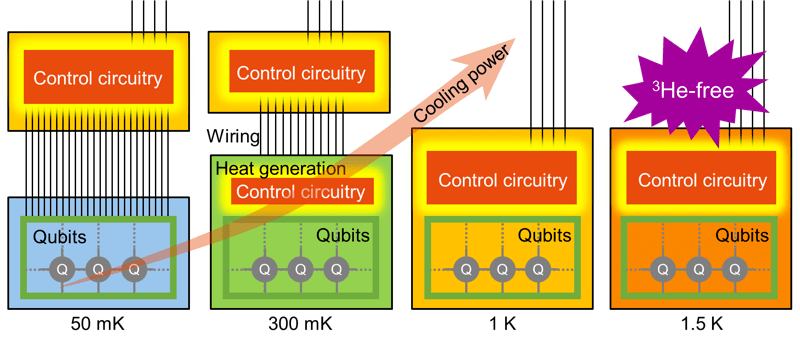Progress Report
Large-scale Silicon Quantum Computer[3] Hot silicon qubits
Progress until FY2024
1. Outline of the project
In this Item, we aim to achieve "high-temperature" operation of silicon qubits, referred to as “hot silicon qubits” (Fig. 1). This involves operating the qubits around 1 Kelvin (K), equivalent to around -272 degrees Celsius. This is higher than the typical operating temperature of solid-state qubits, which is a few tens of millikelvin (mK). By achieving hot silicon qubits, we can improve the permissible circuit power consumption (heat dissipation) and enable closer placement of cryogenic control circuitry. This contributes to the development of large-scale integrated silicon quantum computers. To achieve high-performance hot silicon qubits, we are exploring the "sweet spot" where quantum coherence time is maximized and comparing electron spin and hole spin systems.

2. Outcome so far
Development of elemental techniques for the realization of hot silicon qubits.
① Manipulation: As a 2024 milestone, we observed the coherent time evolution of hole spins at ~1K. In addition, we are advancing technical developments to achieve high-fidelity operation at higher temperatures. For the first time, we demonstrated extension effect of spin phase relaxation time (T2Rabi) using phase-modulated microwaves on hole spins (Figure 2).

② Readout: Radio-frequency (RF) reflectometry measurement method, which is considered promising for high-temperature readout, is a technique used to read the state of a qubit by analyzing the reflectivity of RF signals applied to the qubit system. We achieved the evaluation of spin relaxation time(T1i), the length of time that quantum information can be stored in a qubit, using the technique we developed (Figure 3). [C. Kondo, et al, Jpn. J. Appl. Phys. 64, 01SP09 (2025)]

③ Efforts toward scalability: We are conducting research aimed at scalability from multiple approaches. To realize integrated qubit structures, we proposed a two-dimensional array structure that allows for high-speed and individual control despite its high-density configuration. Additionally, we developed an automatic quantum dot tuning technique using model-based reinforcement learning, which minimizes time-consuming learning processes, unlike other methods. [C. Kondo, et al., APL Mach. Learn. 3, 016114 (2025)] We also evaluated the temperature dependence of charge noise and found that in the hole spin system, noise levels do not significantly increase with temperature rises to 1K, suggesting its promise for high-temperature operation. Furthermore, we are advancing the development of integration techniques for qubits and their control with cryogenic classical circuits. Through collaboration with Kobe University, we confirmed the expected characteristics at 4K for a silicon qubit chip flip-mounted on an interposer. [T. Futaya et al., Jpn. J. Appl. Phys. 63, 03SP64 (2024)] Additionally, we demonstrated selective control using selector circuits implemented on the same interposer.
④Outreach activities: The realization of silicon quantum computers requires the development and integration of individual elemental technologies and techniques. Therefore, it is important to disseminate these technologies to researchers across various fields. For this purpose, we summarized and presented the research trends and prospects of semiconductor qubits, as well as individual elemental technologies and challenges. [T. Kodera, JSAP Rev. 2024, 240101 (2024), etc.] We are also committed to nurturing future quantum human resources who will lead future research and development. We cooperated in holding events such as the QIH-MS6 Co-hosted Quantum Technology Spring School.
3. Future plans
We will evaluate and verify the operation of silicon qubits at 1K by utilizing the knowledge of issues related to higher temperatures and fidelity improvement and techniques for initialization, readout, and manipulation of qubits that we have accumulated up to this fiscal year. In addition, we will conduct benchmark test of electron spin and hole spin systems.